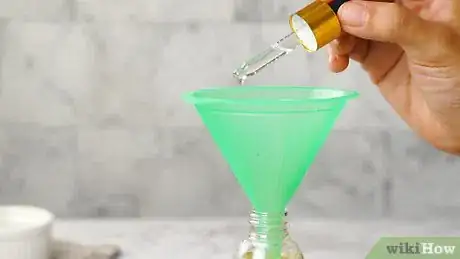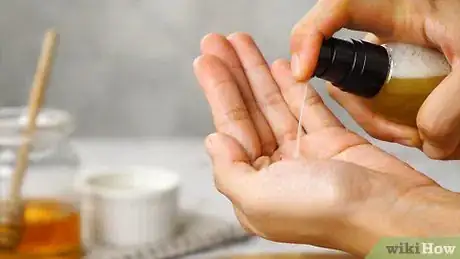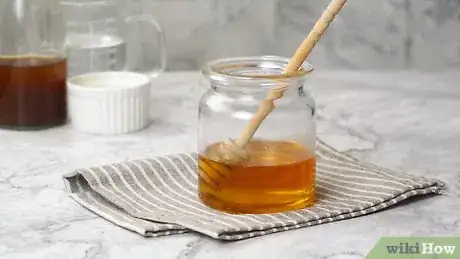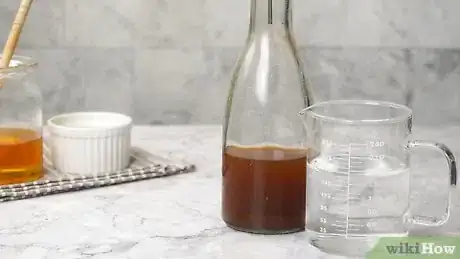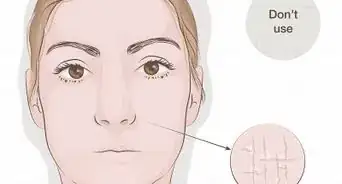This article was co-authored by Mohiba Tareen, MD. Mohiba Tareen is a board certified Dermatologist and the founder of Tareen Dermatology located in Roseville, Maplewood and Faribault, Minnesota. Dr. Tareen completed medical school at the University of Michigan in Ann Arbor, where she was inducted into the prestigious Alpha Omega Alpha honor society. While a dermatology resident at Columbia University in New York City, she won the Conrad Stritzler award of the New York Dermatologic Society and was published in The New England Journal of Medicine. Dr. Tareen then completed a procedural fellowship which focused on dermatologic surgery, laser, and cosmetic dermatology.
This article has been viewed 71,488 times.
Do you like using face wash, but don't like all of the chemicals that go into store-bought ones? Believe it or not, you can make your own face wash at home using just a few ingredients. By making your own cleanser, you get to decide what goes into the face wash and alter the ingredients to suit your needs—and we've put together a couple of face wash recipes to help you get started. In a matter of minutes, you'll be one step closer to cleaner skin.
Ingredients
- ¼ cup (56.25 milliliters) liquid Castile soap
- ¼ cup (56.25 milliliters) chamomile tea or honey
- ¾ teaspoon oil
- 8 drops essential oil (optional)
- Several drops of Vitamin E oil (optional)
Steps
Castile Soap Face Wash
-
1Pour some liquid Castile soap into a clean container. You will need a ¼ cup (56.25 milliliters) of liquid Castile soap. Make sure that it is uncolored and unscented. Any dyes or scents may irritate your skin.
-
2Consider adding chamomile tea to your face wash. Chamomile tea has anti-inflammatory properties and can help reduce redness.[1] If you wish to use chamomile tea in your face wash, brew a cup of chamomile tea and measure out a ¼ cup (56.25 milliliters). Let the tea cool before adding it to the container.Advertisement
-
3Consider adding some honey to your face wash. For a more moisturizing cleanser, use raw honey instead. You will need a ¼ cup (56.25 milliliters). Make sure that it is the runny, translucent sort.
-
4Add the oil. You will need a ¾ teaspoon of natural oil. Here are the types of oil you can use: avocado, coconut, grapeseed, hazelnut, jojoba, olive oil, sunflower oil, or sweet almond.
-
5Consider adding some essential oil. Essential oils can not only make your face wash smell nice, but some oils can be beneficial to certain skin types. You will need about 8 drops of essential oil. Here are some suggestions:[2]
- If you have oily skin, use tea tree oil or any of the following essential oils: bergamot, geranium, or lemongrass.
- If you have dry skin, consider any of the following essential oils: chamomile, lavender, rose, or sandalwood.
- If you have mature skin, use any of the following essential oils: geranium, jasmine, lavender, or neroli.
- Make sure that you are not allergic to the essential oil before adding it to your face wash. If you are not sure if you are allergic to the oil, place a few drops of diluted oil on the inside of your elbow and wait a few hours. If no rash or irritation develops, you can use the oil.
-
6Consider adding some vitamin E oil. You will only need a few drops. It will help moisturize and nourish your skin.
-
7Close the container tightly and shake it. Do this for a few minutes until everything is combined.
-
8Use and store your face wash. You can use this face wash as you would any other face wash. Because you have used some shippable ingredients, such as chamomile tea and honey, however, you will need to store it in the fridge so that it does not expire.
Single-Ingredient Face Wash
-
1Use raw honey to wash and moisturize your face. Dampen your face with warm water. Pour some raw honey onto your fingers and gently massage the honey into your face, avoiding the areas around the eyes and mouth. Rinse the honey off using warm water and pat your face dry with a clean towel.[3]
- For a deeper clean, allow the honey to sit on your face for 5 to 10 minutes.
-
2Use oils to clean your face and makeup. Create a mixture of oils based on your skin type. Gently massage the oil mixture into your face, avoiding the areas around the eyes and mouth. Place a warm, damp towel on your face, and leave it there for one minute. Take the towel off and repeat it with the other side. You will have a little bit of oil on your face, which is good, but you can wash it off with warm water if it is bothersome. Here are a few oil mixtures to try:[4]
- If you have oily skin, use 1 part castor oil or hazelnut oil and 2 parts olive oil or sunflower oil.
- If you have combination skin, use 1 part castor oil or hazelnut oil and 3 parts olive oil or sunflower oil.
- If you have dry skin, use pure olive oil, sunflower oil, or coconut oil. You may add a drop or two of castor oil or hazelnut oil.
-
3Make a face wash and toner using apple cider vinegar and water. Apple cider vinegar is a natural antiseptic, which makes it a great cleanser and toner. Be sure to use unfiltered apple cider vinegar to get all of the benefits. Unfortunately, apple cider vinegar is acidic so you will need to dilute it with some water. Once you have diluted the vinegar, you can use it as a cleaner and toner by dampening a cotton ball with it and wiping your face with the cotton ball. Avoid sensitive areas such as the eyes, nose, and mouth. Here are the proportions you will need, based on your skin type:
- If you have oily skin, use 1 part apple cider vinegar and 1 part water.
- If you have normal skin, use 1 part apple cider vinegar and 2 parts water.
- If you have sensitive skin, use 1 part apple cider vinegar and 4 parts water.
- Be sure to do a patch test on the inside of your elbow before using the vinegar-water mixture on your entire face. If you get an allergic reaction, do not use this face wash.
Expert Q&A
-
QuestionCan I use castor oil as an oil cleanser?
 Chloe GoldmanDr. Chloe Goldman, MD is a Dermatologist based in Miami, Florida, who currently works at Baumann Cosmetic & Research Institute and Upper East Side Dermatology. She specializes in cosmetic, medical, and surgical dermatology. She earned a Doctor of Medicine from New York University and a BA in Biology, Neurobiology, and Behavior from Cornell University. She completed her dermatology training at University of Miami, where she was awarded the prestigious position of Chief Resident. She has won grants from the American Skin Foundation and the Melanoma Research Foundation.
Chloe GoldmanDr. Chloe Goldman, MD is a Dermatologist based in Miami, Florida, who currently works at Baumann Cosmetic & Research Institute and Upper East Side Dermatology. She specializes in cosmetic, medical, and surgical dermatology. She earned a Doctor of Medicine from New York University and a BA in Biology, Neurobiology, and Behavior from Cornell University. She completed her dermatology training at University of Miami, where she was awarded the prestigious position of Chief Resident. She has won grants from the American Skin Foundation and the Melanoma Research Foundation.
Board-certified Dermatologist That's not a great idea. Castor oil can be used to remove oil-soluble things from your face (like makeup or sunscreen), but it's not a replacement for face wash. If you have oily skin, you shouldn't use castor oil at all.
That's not a great idea. Castor oil can be used to remove oil-soluble things from your face (like makeup or sunscreen), but it's not a replacement for face wash. If you have oily skin, you shouldn't use castor oil at all. -
QuestionWhat ingredients make a good face wash?
 Mohiba Tareen, MDMohiba Tareen is a board certified Dermatologist and the founder of Tareen Dermatology located in Roseville, Maplewood and Faribault, Minnesota. Dr. Tareen completed medical school at the University of Michigan in Ann Arbor, where she was inducted into the prestigious Alpha Omega Alpha honor society. While a dermatology resident at Columbia University in New York City, she won the Conrad Stritzler award of the New York Dermatologic Society and was published in The New England Journal of Medicine. Dr. Tareen then completed a procedural fellowship which focused on dermatologic surgery, laser, and cosmetic dermatology.
Mohiba Tareen, MDMohiba Tareen is a board certified Dermatologist and the founder of Tareen Dermatology located in Roseville, Maplewood and Faribault, Minnesota. Dr. Tareen completed medical school at the University of Michigan in Ann Arbor, where she was inducted into the prestigious Alpha Omega Alpha honor society. While a dermatology resident at Columbia University in New York City, she won the Conrad Stritzler award of the New York Dermatologic Society and was published in The New England Journal of Medicine. Dr. Tareen then completed a procedural fellowship which focused on dermatologic surgery, laser, and cosmetic dermatology.
FAAD Board Certified Dermatologist Mixing honey and lemon is perfect for the antioxidant, antiseptic, and moisturizing properties. Take one teaspoon of honey and add a few drops of lemon and a little water, rub mixture on the face and clean with warm water. Apple cider vinegar is also good, but can be irritating to anyone with sensitive skin, so be mindful of that before use. It helps balance the pH levels in the skin and acts as a great cleanser as it unclogged pores, and can aid in reducing the appearance of dark spots and hyperpigmentation.
Mixing honey and lemon is perfect for the antioxidant, antiseptic, and moisturizing properties. Take one teaspoon of honey and add a few drops of lemon and a little water, rub mixture on the face and clean with warm water. Apple cider vinegar is also good, but can be irritating to anyone with sensitive skin, so be mindful of that before use. It helps balance the pH levels in the skin and acts as a great cleanser as it unclogged pores, and can aid in reducing the appearance of dark spots and hyperpigmentation. -
QuestionHow do you use yogurt as a face wash?
 Mohiba Tareen, MDMohiba Tareen is a board certified Dermatologist and the founder of Tareen Dermatology located in Roseville, Maplewood and Faribault, Minnesota. Dr. Tareen completed medical school at the University of Michigan in Ann Arbor, where she was inducted into the prestigious Alpha Omega Alpha honor society. While a dermatology resident at Columbia University in New York City, she won the Conrad Stritzler award of the New York Dermatologic Society and was published in The New England Journal of Medicine. Dr. Tareen then completed a procedural fellowship which focused on dermatologic surgery, laser, and cosmetic dermatology.
Mohiba Tareen, MDMohiba Tareen is a board certified Dermatologist and the founder of Tareen Dermatology located in Roseville, Maplewood and Faribault, Minnesota. Dr. Tareen completed medical school at the University of Michigan in Ann Arbor, where she was inducted into the prestigious Alpha Omega Alpha honor society. While a dermatology resident at Columbia University in New York City, she won the Conrad Stritzler award of the New York Dermatologic Society and was published in The New England Journal of Medicine. Dr. Tareen then completed a procedural fellowship which focused on dermatologic surgery, laser, and cosmetic dermatology.
FAAD Board Certified Dermatologist Greek yogurt can help with cleansing the skin while also adding deep moisture to the skin. It can also help reduce dirt and oil from the skin. For acne prone skin, adding a pinch of turmeric (occasionally) can have an anti-inflammatory and antibacterial effect.
Greek yogurt can help with cleansing the skin while also adding deep moisture to the skin. It can also help reduce dirt and oil from the skin. For acne prone skin, adding a pinch of turmeric (occasionally) can have an anti-inflammatory and antibacterial effect.
Warnings
- Do not use nut-based oils if you are allergic to nuts.⧼thumbs_response⧽
- Perform a patch test if you are not sure whether or not you are allergic to apple cider vinegar or a certain essential oil.⧼thumbs_response⧽
Things You'll Need
- Water
- Container to store your face wash
Expert Interview

Thanks for reading our article! If you'd like to learn more about face cleaning, check out our in-depth interview with Mohiba Tareen, MD.
References
- ↑ DIY Natural, Homemade Face Wash – A Natural Facial Cleanser
- ↑ DIY Natural, Homemade Face Wash – A Natural Facial Cleanser
- ↑ Wellness Mama, Homemade Honey Face Wash
- ↑ Wellness Mama, Oil Cleansing for Naturally Perfect Skin
